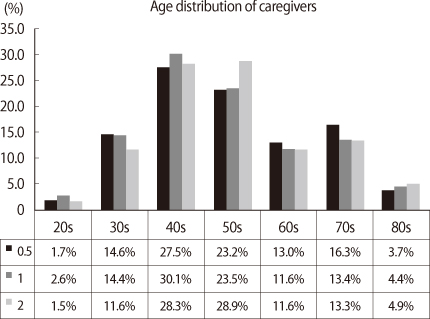Who Takes Care of Patients with Dementia in Korea: A Study on the Present State of Patients with Dementia Living Alone and Primary Caregivers
- Affiliations
-
- 1Department of Neurology, Konyang University College of Medicine, Daejeon, Korea.
- 2Department of Neurology, The Catholic University of Korea College of Medicine, Seoul, Korea. neuroman@catholic.ac.kr
- KMID: 2172261
- DOI: http://doi.org/10.12779/dnd.2012.11.1.13
Abstract
- BACKGROUND
Cultural characteristics of taking care of patients with dementia in Korea are based on the influence of Confucianism on the lifestyle of Koreans. In addition, as the family size has been getting smaller, the number of old persons who live alone has been increasing. The purpose of this study is to examine the proportion of the elderly with dementia who live alone and demographics of caregivers when such patients live with their family.
METHODS
From the multiple hospital-based cohort, 973 elderly patients with very mild dementia (Clinical Dementia Rating [CDR]=0.5), 1,056 patients with mild dementia (CDR=1) and 359 patients with moderate dementia (CDR=2) were recruited. We analyzed the proportion of the patients with dementia who live alone and the demographics of the caregivers if such patients live with and are taken care of by such caregivers depending upon the severity of dementia.
RESULTS
The proportion of the patients with dementia who live alone accounts for about 40% of all elderly patients with dementia. Major age groups of caregivers are of 40s and 50s. Sons, daughters, and spouses were ranked in the said order in the proportion of caregivers according to their relationship to patients.
CONCLUSIONS
Up to now, family members care for about 60% of elderly patients with dementia, which may suggest that from the objective viewpoint, direct burden borne by caregivers for old patients with dementia would be considerably high. On the other hand, about 40% of dementia patients live alone, implying that the social care system is needed for them.
Keyword
MeSH Terms
Figure
Cited by 6 articles
-
The Consideration about Usefulness of Mass Screening for Dementia
Hojin Choi, Hee-Jin Kim, Kyoung Hee Kim, Seong-il Oh, Seung Hyun Kim
Dement Neurocogn Disord. 2014;13(4):117-120. doi: 10.12779/dnd.2014.13.4.117.The Consideration about Usefulness of Mass Screening for Dementia
Hojin Choi, Hee-Jin Kim, Kyoung Hee Kim, Seong-il Oh, Seung Hyun Kim
Dement Neurocogn Disord. 2014;13(4):117-120. doi: 10.12779/dnd.2014.13.4.117.Driving in Patients with Dementia: A CREDOS (Clinical Research Center for Dementia of South Korea) Study
Seong Hye Choi, Jiwook Lee, Soo Jeong Kim, Jun Yong Choi, Ji Won Kwon, Byung-Nam Yoon, Jong Hun Kim, Bora Yoon, YoungSoon Yang, SangYun Kim, Jee Hyang Jeong
Dement Neurocogn Disord. 2014;13(4):83-88. doi: 10.12779/dnd.2014.13.4.83.Driving in Patients with Dementia: A CREDOS (Clinical Research Center for Dementia of South Korea) Study
Seong Hye Choi, Jiwook Lee, Soo Jeong Kim, Jun Yong Choi, Ji Won Kwon, Byung-Nam Yoon, Jong Hun Kim, Bora Yoon, YoungSoon Yang, SangYun Kim, Jee Hyang Jeong
Dement Neurocogn Disord. 2014;13(4):83-88. doi: 10.12779/dnd.2014.13.4.83.Factors Influencing Quality of Caregiving by Caregivers for Elders with Dementia
Chan Mi Kang, Jung Soon Kim, Jeong Hee Jeong
J Korean Acad Community Health Nurs. 2016;27(3):193-201. doi: 10.12799/jkachn.2016.27.3.193.Comparison of Sleep Quality between Families of Dementia Patients and General Population in Community: Analysis with the Korea Community Health Survey
Mina Kim, Young-Hoon Lee
Korean J Health Promot. 2023;23(3):139-146. doi: 10.15384/kjhp.2023.23.3.139.
Reference
-
1. WHO. 2004 World population data sheet of the population reference bureau. 2004. Geneva: WHO.2. Statistics Korea. 2006. http://www.nso.go.kr.3. Nationwide study on the prevalence of dementia in Korean elders. 2008. Seoul: Seoul National University Hospital.4. Mohamed S, Rosenbeck R, Lyketsos CG, Schneider LS. Caregiver burden in Alzheimer disease: cross-sectional and longitudinal patient correlates. Am J Geriatr Psychiatry. 2010. 18:917–927.5. Raccichini A, Castellani S, Civerchia P, Fioravanti P, Scarpino O. The Caregiver's burden of Alzheimer patients: differences between live-in and non-live-in. Am J Alzheimers Dis Other Demen. 2009. 24:377–383.6. Kiecolt-Glaser JK, Dura JR, Speicher CE, Trask OJ, Glaser R. Spousal caregivers of dementia victims: longitudinal changes in immunity and health. Psychosom Med. 1991. 53:345–362.7. Grafström M, Fratiglioni L, Sandman PO, Winblad B. Health and social consequences for relatives of demented and non-demented elderly. A population-based study. J Clin Epidemiol. 1992. 45:861–870.8. Statistics Korea. 2001. http://www.nso.go.kr.9. Statistics Korea. 2010. http://www.nso.go.kr.10. Morris JC. The Clinical Dementia Rating (CDR): current version and scoring rules. Neurology. 1993. 43:2412–2414.11. Statistics Korea. 2002. http://www.nso.go.kr.12. The Socioeconomic Problems of an Aging Society and Policy Responses. 2003. Korea Institute for Health and Social Affairs.13. Kim Yeong-in. A Study on Quality of Life and Burden of Caregiving of Primary Caregiver of Demented Elderly. 2008. Wonkang University.14. Jang Min-Gi. A Study on The Factors of Caregivers Burden with The Senile Dementia Patients. 2009. The Graduate School Kyungsung University.
- Full Text Links
- Actions
-
Cited
- CITED
-
- Close
- Share
- Similar articles
-
- Influence of Self-care on Burnout in Primary Family Caregiver of Person with Dementia
- Factors Affecting On Caregiving Self-efficacy among Dementia Caregivers
- Influencing Factors on Care Burden among Family Caregivers for Elders with Dementia: Focusing on Family Caregivers using a Support Center for Dementia
- A General Guideline on Caregiving for Dementia Patients
- A Clinical Approach for Patients with Dementia



